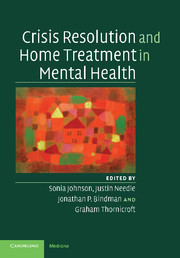Book contents
- Frontmatter
- Contents
- List of contributors
- Foreword
- Acknowledgements
- Section 1 Introduction and concepts
- Section 2 The evidence
- 4 The classic home treatment studies
- 5 Recent research on crisis resolution teams: findings and limitations
- Section 3 Current practice
- Section 4 Variations and enhancements
- Section 5 Developing a local service
- Index
- References
4 - The classic home treatment studies
from Section 2 - The evidence
Published online by Cambridge University Press: 13 August 2009
- Frontmatter
- Contents
- List of contributors
- Foreword
- Acknowledgements
- Section 1 Introduction and concepts
- Section 2 The evidence
- 4 The classic home treatment studies
- 5 Recent research on crisis resolution teams: findings and limitations
- Section 3 Current practice
- Section 4 Variations and enhancements
- Section 5 Developing a local service
- Index
- References
Summary
From the 1960s to the late 1980s, a series of studies, most of them randomised trials comparing groups receiving an innovative service with traditional hospital-based care, examined the feasibility of managing crises at home rather than in hospital. These studies have been highly influential, cited, for example, in the Mental Health Policy Implementation Guide as supporting evidence for crisis resolution teams (CRTs) (Department of Health, 2001). In this chapter, we summarise these studies and their results, and we analyse the extent to which they provide evidence for the current CRT model. Most of the studies relate to service models already mentioned in Chapter 2 and all were carried out more than a decade ago. Chapter 5 describes more recent evidence that varies in methodological quality but is more clearly related to the CRT model in its contemporary form.
Methods and aims
A literature review using the main electronic databases forms the basis for this chapter, and we also examined previous reviews of randomised controlled trials (RCTs) of crisis intervention by Joy and colleagues (2000) for the Cochrane Library of Systematic Reviews, and of randomised and non-randomised comparative studies on home treatment by Burns and colleagues (2001). Our aim in this chapter has been to identify all studies that compare a group cared for by an innovative service involving home-based treatment as a substitute for acute admission with a group where this was not available.
- Type
- Chapter
- Information
- Crisis Resolution and Home Treatment in Mental Health , pp. 37 - 50Publisher: Cambridge University PressPrint publication year: 2008
References
- 3
- Cited by



